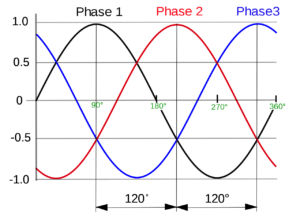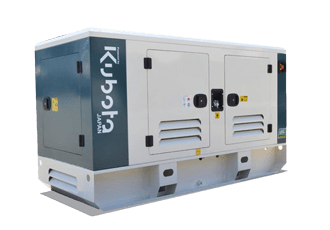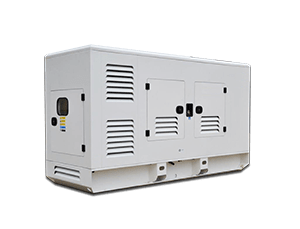Three Phase Current – Calculation
Three Phase Power and Current
The power was taken by a circuit (single or three-phase) is measured in watts W (or kW). The product of the voltage and current is the apparent power and measured in VA (or kVA). The relationship between kVA and kW is the power factor (Pf):

kW = kVA x pf
which can also be expressed as:
kVA = kW/pf
Single phase system
this is the easiest to deal with. Given the kW and power factor, the kVA can be easily worked out. The current is simply the kVA divided by the voltage. As an example, consider a load consuming 23 kW of power at 230 V and a power factor of 0.86:
kVA = kW / power factor = 23/0.86 = 26.7 kVA (26700VA)
Current = VA / voltage = 26700 / 230 = 116 A
Note: you can do these equations in either VA, V, and A or kVA, kV, and KA depending on the parameters you are dealing with. To convert from VA to kVA just divide by 1000.
Three phase system
The main difference between a three-phase system and a single-phase system is the voltage. In a three-phase system, we have the line to line voltage (VLL) and the phase voltage (VLN), related by:
VLL =√3 x VLN
or alternatively as:
VLN = VLL / √3
the easiest way to solve three-phase problems is to convert them to a single-phase problem. Take a three-phase motor (with three windings, each identical) consuming a given kW. The kW per winding (single-phase) has to be the total divided by 3. Similarly, a transformer (with three windings, each identical) supplying a given kVA will have each winding supplying a third of the total power. To convert a three-phase problem to a single phase problem take the total kW (or kVA) and divide it by three.
As an example, consider a balanced three phase load consuming 36 kW at a power factor of 0.86 and line to line voltage of 400 V (VLL) :
note: the line to neutral (phase) voltage VLN = 400/ √3 = 230 V
three phase power is 36 kW, single phase power = 36/3 = 12 kW
now simply follow the above single phase method
kVA = kW / power factor = 12 / 0.86 = 13.9 kVA (13900 VA)
Current = VA / voltage = 13900 / 230 = 60 A
Easy enough. To find the power given current, multiply by the voltage and then the power factor to convert to W. For a three-phase system multiply by three to get the total power.
Unbalanced Three Phase Systems
The above deals with balanced three-phase systems. That is the current in each phase is the same and each phase delivers or consumes the same amount of power. This is typical of power transmission systems, electrical motors, and similar types of equipment.
Often where single-phase loads are involved, residential and commercial premises, for example, the system can be unbalanced with each phase have a different current and delivering or consuming a differing amount of power.
Balanced Voltages
Luckily in practice voltages tend to be fixed or very by only small amounts. In this situation and with a little thought it is possible to extend the above type of calculation to unbalanced current three-phase systems. The key to doing this is that the sum of power in each phase is equal to the total power of the system.
For example, take a 400 V (VLL) three phase system with the following loads: phase 1 = 80 A, phase 2 = 70 A, phase 3 = 82 A
the line to neutral (phase) voltage VLN = 400/√3 = 230 V
phase 1 apparent power = 80 x 230 = 18,400 VA = 18.4 kVA
phase 2 apparent power = 70 x 230 = 16,100 VA = 16.1 kVA
phase 3 apparent power = 82 x 230 = 18,860 VA = 18.86 kVA
Total three phase power = 18.4 + 16.1 + 18.86 = 53.36 kVA
Similarly given the power in each phase you could easily find the phase currents. If you also know the power factor you can convert between kVA and kW as shown earlier.
Unbalanced Voltages
If the voltages become unbalanced or there are other considerations (i.e. unbalanced phase shift), then it is necessary to revert to a more traditional network analysis. System voltages and currents can be found by drawing out the circuit in full detail and using Kirchhoff’s laws and other network theorems.
How to know the right generator for you
if you have already calculated the total actual load (Total three-phase power), now you can use the following formulas to choose the right generator for you.
first of all, there are two terms of diesel generators powers, one is the standby power and the second is the prime power
Prime Power of the generator set
the prime power of the generator set is the 100% capacity of the generator, and this is where a variable load and unlimited hour usage are applied with an average load factor of 80% of the prime rating over each 24-hour period. Noting that a 10% overload is permitted for 1hour in every 12-hour operation.
Stand-by Power of the generator set
the stand-by power of the generator set is the 110% capacity of the generator, and this is where a variable load limited to an annual usage of up to 500 hours is applied, with 300 hours of which may be continuous running. Noting that no overload is permitted.
Conclusion:
so if you are choosing the right generator for your calculated total load, you should multiply the total load by 1.25 to get the prime power rate. by doing that you are now running at 80% of the prime power rate.
note: it is a good practice to add extra virtual load to your total load like 10% for future added equipment. and you should not go below 40% of prime power rates at all.



